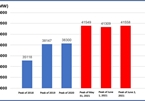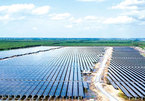 |
|
|
The proportion of renewable energy in the Draft Power Development Planning 8 will increase to nearly 30% by 2030 compared to 16.3% in the adjusted Draft Power Development Planning 7. However, the development of wind power and solar power in the near future will not be as easy as before.
Regulations in renewable energy investment will be stricter, creating fierce competition among investors, especially in terms of price, according to the criterion that the investor with the lowest price will be given priority.
According to the Electricity of Vietnam (EVN)'s statistics, the proportion of wind and solar power sources in the national power system is on the rise. On a national scale, the proportion of wind power and solar power in the total capacity in 2020 reached 24% (16,941 MW/ 69,342 MW). In 2021, this proportion will further increase, including thousands of MW of wind power.
The explosion of solar power and wind power plants, mainly in the Central and South regions (accounting for 96%), has caused many problems in power transmission and capacity overload.
Therefore, the Ministry of Industry and Trade (MoIT) is developing a new strategy on renewable energy with significant changes.
Accordingly, the MoIT will no longer apply the FIT price as before. It will set the price annually and announce the ceiling price and price for wind and solar power.
Under the Draft Power Development Planning 8, wind and solar power capacity will be allocated to provinces based on their grid transmission capacity and demand, etc. Based on this, provinces will organize bidding to select investors. However, they will have to consult the MoIT on the conformity with the electricity planning and the EVN on the connection, operation and capacity release plan.
Investors must have experience and financial capacity, ensure at least 30% reciprocal capital, have participated in investment or have been the main contractor of at least 3 projects in the energy sector or in the infrastructure sector.
Priority is given to investors who offer low prices
The investor in wind and solar power projects will be selected based on the price framework for solar and wind power generation issued by the MoIT.
Investors who meet the technical criteria and propose the highest discount rate compared to the ceiling price are ranked first and are recommended for being chosen. In case there are two or more investors offering the same prices with the highest discount rate compared to the ceiling price, the one with the higher technical score will be selected. If they have the same technical score, they will be asked to re-propose the electricity price reduction rate and the one with the highest rate will be chosen.
After that, the two sides will negotiate and sign the contract. If this procedure is failed, the investor who ranks second in the bidding round will be invited for negotiation.
After signing the agreement with the local government, the investor will compile a dossier of electricity price negotiation and signs a Power Purchase Agreement (PPA) with the EVN. The negotiation period is 6 months for solar power and 24 months for wind power. If the negotiation fails, the investor will be rejected and they will bear the costs of bidding and project development.
Thus, forecasting selling prices for wind and solar power projects will be much more difficult. If the Government implements this plan, only capable and experienced investors are able to offer low selling price to be selected.
Luong Bang

A paradox of power consumption and generation
Renewable energy output is being reduced even as Vietnam is seeing blackouts as power consumption is off the charts.

Renewable energy companies thrive on rising demand
In the first half of 2021, renewable energy projects, especially solar power, brought great profits to investors, boosting the sector's stocks.